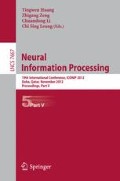Abstract
We can observes a section of the body using MRI and CT . CT is suitable for the blood flow and the diagnosis of the wrong point of the bone by the computed tomograph, and MRI is suitable for the diagnosis of the cerebral brain infarction and the brain tumor. Because different nature is observed to so same the observation object, a, doctor, uses CT and an MRI image complementary, and sees a patient. The feature which appears in both images remarkably is extracted using the CT image and the MRI image by this paper. Various three-dimensional filters are generated using the ICA base in the self-histionic target from the characteristic image for that image, and how to extract a remarkable feature from the feature image which could get is proposed by this research. A remarkable feature is extracted from the CT image and the MRI image of the patient which actually has a tumor , and its effectiveness is shown.
Access this chapter
Tax calculation will be finalised at checkout
Purchases are for personal use only
Preview
Unable to display preview. Download preview PDF.
References
Marr, D.: VISION. WHF Freeman and Company (1982)
Koch, C., Ullman, S.: Shifts in selective visual-attention towards the underlying neural circuitry. Hum. Neurobiol. 4, 219–227 (1985)
Itti, L., Koch, C.: Feature combination strategies for saliency-based visual attention systems. J. Electron Imaging 10(1), 161–169 (2001)
Mallet, S.G.: A theory for multiresolution signal decomposition: The wavelet representation. IEEE Tran. on PAMI 11, 674–693 (1989)
Hyvarinen, A., Hoyer, P.O.: Emergence of phase and shift invariant features by decomposition of natural images into independent feature subspace. Neural Computation 12(7), 1705–1720 (2000)
Hubel, D.H., Wiesel, T.N.: Receptive fields, binocular interaction and functional architecture in the cat’s visual cortex. J. Physiol. 160, 106–154 (1962)
Hubel, D.H., Wiesel, T.N.: Receptive fields of cells in striate cortex of very young, visually inexperienced kittens. J. Neurophysiol. 26, 994–1002 (1963)
Blakemore, C., Cooper, G.F.: Development of the brain depends on the visual environment. Nature 228, 477–478 (1970)
Blakemore, C., Mitchell, D.E.: Environmental modification of the visual cortex and the neural basis of learning and memory. Nature 241, 467–468 (1973)
von der Malsburg, C.: Self-organization of orientation sensitive cells in the striate cortex. Kybernetik 14, 85–100 (1973)
Willshaw, D.J., von der Malsburg, C.: How patterned neural connections can be set up by self-organization. Proc. R. Soc. Land. B. 194, 431–445 (1976)
Kohonen, T.: Self-organized formation of topographically corerct feature maps. Biol. Cybern. 43, 59–69 (1982)
Horn, B.K., Schunck, B.G.: Determining optical flow. Artif. Intell. 17, 185–203 (1981)
Morita, S.: Generating Saliency Map Related to Motion Based on Self-organized Feature Extracting. In: Köppen, M., Kasabov, N., Coghill, G. (eds.) ICONIP 2008, Part II. LNCS, vol. 5507, pp. 784–791. Springer, Heidelberg (2008)
Morita, S.: Generating Self-organized Saliency Map Based on Color and Motion. In: Leung, C.S., Lee, M., Chan, J.H. (eds.) ICONIP 2009, Part II. LNCS, vol. 5864, pp. 28–37. Springer, Heidelberg (2009)
Author information
Authors and Affiliations
Editor information
Editors and Affiliations
Rights and permissions
Copyright information
© 2012 Springer-Verlag Berlin Heidelberg
About this paper
Cite this paper
Morita, S. (2012). Self-Organized Three Dimensional Feature Extraction of MRI and CT. In: Huang, T., Zeng, Z., Li, C., Leung, C.S. (eds) Neural Information Processing. ICONIP 2012. Lecture Notes in Computer Science, vol 7667. Springer, Berlin, Heidelberg. https://doi.org/10.1007/978-3-642-34500-5_9
Download citation
DOI: https://doi.org/10.1007/978-3-642-34500-5_9
Publisher Name: Springer, Berlin, Heidelberg
Print ISBN: 978-3-642-34499-2
Online ISBN: 978-3-642-34500-5
eBook Packages: Computer ScienceComputer Science (R0)

